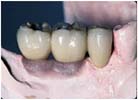A dental crown is a tooth-shaped "cap" that is placed over a tooth -- to cover the tooth to restore its shape and size, strength, and improve its appearance.
The crowns, when cemented into place, fully encase the entire visible portion of a tooth that lies at and above the gum line.
See Before and After Pictures of Cosmetic Dentistry :
A dental crown may be needed in the following situations:
- To protect a weak tooth (root canal treated tooth)
- To restore an already broken tooth or a tooth that has been severely worn down
- To cover and support a tooth with a large filling when there isn't a lot of tooth left
- To hold a dental bridge in place
- To cover misshaped or severely discolored teeth
- To cover a dental implant
- To make a cosmetic modification
Root canal treatment consists of several steps that take place over several office visits, depending on the situation. These steps are:
- Temporary crowns: these crowns are acrylic or metal alloy .They cover the tooth while a permanent crown is being created in our in-house dental lab.
-
 Stainless steel crowns:
These are prefabricated crowns that are used on permanent and baby teeth. Stainless steel crowns are generally used for
children's teeth because they are cost-effective and can be put on in one visit. The crown covers the entire tooth and
protects it from further decay. When the primary tooth comes out to make room for the permanent tooth, the crown comes out
naturally with it
Stainless steel crowns:
These are prefabricated crowns that are used on permanent and baby teeth. Stainless steel crowns are generally used for
children's teeth because they are cost-effective and can be put on in one visit. The crown covers the entire tooth and
protects it from further decay. When the primary tooth comes out to make room for the permanent tooth, the crown comes out
naturally with it -
Metal crowns : These crowns can be made from cast gold alloys or cast silver palladium alloys. With a metal crown, less tooth structure needs to be removed and the wear on opposing teeth is minimal. Metal crowns withstand biting and chewing well and last the longest. They also rarely chip or break. The metallic color is the main drawback. Metal crowns are a good choice for out-of-sight molars.
-
 Porcelain-fused-to-metal crowns:
These dental crowns contain an inner metal casting with porcelain baked over it. They look natural and can be very aesthetic.
Occasionally they may chip and show the underlying metal. Next to all-ceramic crowns, porcelain-fused-to-metal crowns look
most like normal teeth
Porcelain-fused-to-metal crowns:
These dental crowns contain an inner metal casting with porcelain baked over it. They look natural and can be very aesthetic.
Occasionally they may chip and show the underlying metal. Next to all-ceramic crowns, porcelain-fused-to-metal crowns look
most like normal teeth
-
 All-ceramic or all-porcelain dental crowns provide better natural color match than any other crown type
and may be more suitable for people with metal allergies. However, they are not as strong as porcelain-fused-to-metal crowns.
All-ceramic crowns are a good choice for front teeth.
All-ceramic or all-porcelain dental crowns provide better natural color match than any other crown type
and may be more suitable for people with metal allergies. However, they are not as strong as porcelain-fused-to-metal crowns.
All-ceramic crowns are a good choice for front teeth.
Missing a tooth and having a gap in between your teeth isn’t just unsightly, it can cause other problems. Talking and chewing may be
difficult. Teeth adjacent to the space will eventually begin to shift into the empty space which will affect your bite, may lead to
gum disease and possibly even jaw joint disorders like temporomandibular joint (TMJ) issues.
One way to take care of a gap caused by a missing tooth is with a dental bridge. There are removable dental bridges, also called
partial dentures, that can be removed and cleaned like dentures, and there are permanent dental bridges, sometimes called fixed
partial dentures.
A dental bridge is called a bridge because it literally bridges the gap where one or more teeth used to be. Bridges are cemented to
the teeth adjacent to the empty space. The adjacent teeth, called abutments, serve as the anchors for the bridge. The adjacent teeth
are trimmed down and capped with a crown, and then a replacement tooth, called a pontic, is attached to those crowns to form the
bridge. The unit is securely cemented to your teeth and your smile and ability to chew food is improved.
- Restore the ability to chew and speak properly
- Maintain the shape of your face, preventing lip or face collapse
- Distribute the forces in your bite to alleviate stress on other teeth
There are several types of dental bridges. Each bridge is made with different materials and is better suited for certain areas of the mouth and for certain types of situations. Your Dental Associates dentist will recommend the best type of dental bridge based on your individual circumstance.
-
 Traditional bridges:
these are the most common dental bridges. They involve creating a crown for the tooth (abutment) on either side of the missing
tooth, with a replacement tooth (pontic) in between. Traditional bridges are made of either porcelain fused to metal or
ceramic.
Traditional bridges:
these are the most common dental bridges. They involve creating a crown for the tooth (abutment) on either side of the missing
tooth, with a replacement tooth (pontic) in between. Traditional bridges are made of either porcelain fused to metal or
ceramic. -
 Cantilever bridges:
these bridges are used when the replacement tooth can only be supported from one side. A cantilever dental bridge is typically
used when the space is small and the stresses will be minimal
Cantilever bridges:
these bridges are used when the replacement tooth can only be supported from one side. A cantilever dental bridge is typically
used when the space is small and the stresses will be minimal -
 Maryland bonded bridges :
this dental bridge is most commonly used to bridge front teeth together. The Maryland bridge technique, named after the
University of Maryland Dental School where it was developed, uses metal or resin “wings” on each side of the bridge that are
bonded to the existing teeth. A Maryland bonded bridge is also called a resin-bonded bridge. One of its big advantages is that
it requires very little shaping, if any, of the anchor teeth.
Maryland bonded bridges :
this dental bridge is most commonly used to bridge front teeth together. The Maryland bridge technique, named after the
University of Maryland Dental School where it was developed, uses metal or resin “wings” on each side of the bridge that are
bonded to the existing teeth. A Maryland bonded bridge is also called a resin-bonded bridge. One of its big advantages is that
it requires very little shaping, if any, of the anchor teeth.
-
 Implant-supported dental bridges
these bridges are recommended if you’re missing more than one tooth. This technique involves the placement of two or more
dental implants with space between them. These implants serve as the abutments (anchors) for the permanently cemented
bridgework. Because dental implants simulate tooth roots, they maintain the integrity of the jaw bone and provide a solid
support for the bridge.
Implant-supported dental bridges
these bridges are recommended if you’re missing more than one tooth. This technique involves the placement of two or more
dental implants with space between them. These implants serve as the abutments (anchors) for the permanently cemented
bridgework. Because dental implants simulate tooth roots, they maintain the integrity of the jaw bone and provide a solid
support for the bridge.








